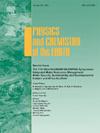Microplastics in Indian freshwater systems: Multidisciplinary analysis of sources, consequences, and mitigation strategies
IF 3
3区 地球科学
Q2 GEOSCIENCES, MULTIDISCIPLINARY
引用次数: 0
Abstract
Microplastic (MP) pollution represents an escalating environmental hazard, especially in India's freshwater ecosystems, where intensified industrial activities, urbanization, and insufficient waste management have exacerbated contamination. Freshwater ecosystems in India, encompassing rivers, lakes, and reservoirs, are particularly susceptible owing to their significance in sustaining biodiversity, providing potable water, and facilitating agriculture. This study examines the extent, origins, and effects of MP pollution in Indian freshwater systems, emphasising essential research areas to mitigate the associated ecological and public health hazards. This study initially examines the present condition of MP contamination in Indian freshwater systems, pinpointing key sources, including urban wastewater, industrial effluents, and agricultural runoff. This article, subsequently analyse current studies regarding the effects of these pollutants on aquatic ecosystems and underscores critical knowledge deficiencies, especially in evaluating MP toxicity and its interactions with other contaminants. Emphasising the necessity for a multidisciplinary approach, we propose targeted research directions: enhancing monitoring methodologies, developing cost-effective remediation strategies, and examining the socioeconomic factors that contribute to the persistence of pollution. The significance of policy interventions and public awareness campaigns in bolstering scientific efforts to alleviate microplastic pollution has been underscored. This thorough analysis provides actionable insights for researchers, policymakers, and environmental stakeholders seeking sustainable solutions to restore the health and resilience of Indian freshwater ecosystems.

印度淡水系统中的微塑料:来源、后果和缓解战略的多学科分析
微塑料(MP)污染是一种不断升级的环境危害,特别是在印度的淡水生态系统中,工业活动加剧、城市化和废物管理不足加剧了污染。在印度,包括河流、湖泊和水库在内的淡水生态系统尤其容易受到影响,因为它们在维持生物多样性、提供饮用水和促进农业方面具有重要意义。本研究考察了印度淡水系统中MP污染的程度、来源和影响,强调了减轻相关生态和公共健康危害的基本研究领域。本研究初步考察了印度淡水系统中MP污染的现状,确定了主要污染源,包括城市废水、工业废水和农业径流。本文随后分析了目前关于这些污染物对水生生态系统影响的研究,并强调了关键的知识缺陷,特别是在评估MP毒性及其与其他污染物的相互作用方面。强调多学科方法的必要性,我们提出了有针对性的研究方向:加强监测方法,开发具有成本效益的补救策略,以及研究导致污染持续存在的社会经济因素。会议强调了政策干预和公众意识运动在加强减轻微塑料污染的科学努力方面的重要性。这一深入的分析为研究人员、政策制定者和环境利益相关者寻求可持续的解决方案,以恢复印度淡水生态系统的健康和弹性提供了可行的见解。
本文章由计算机程序翻译,如有差异,请以英文原文为准。
求助全文
约1分钟内获得全文
求助全文
来源期刊

Physics and Chemistry of the Earth
地学-地球科学综合
CiteScore
5.40
自引率
2.70%
发文量
176
审稿时长
31.6 weeks
期刊介绍:
Physics and Chemistry of the Earth is an international interdisciplinary journal for the rapid publication of collections of refereed communications in separate thematic issues, either stemming from scientific meetings, or, especially compiled for the occasion. There is no restriction on the length of articles published in the journal. Physics and Chemistry of the Earth incorporates the separate Parts A, B and C which existed until the end of 2001.
Please note: the Editors are unable to consider submissions that are not invited or linked to a thematic issue. Please do not submit unsolicited papers.
The journal covers the following subject areas:
-Solid Earth and Geodesy:
(geology, geochemistry, tectonophysics, seismology, volcanology, palaeomagnetism and rock magnetism, electromagnetism and potential fields, marine and environmental geosciences as well as geodesy).
-Hydrology, Oceans and Atmosphere:
(hydrology and water resources research, engineering and management, oceanography and oceanic chemistry, shelf, sea, lake and river sciences, meteorology and atmospheric sciences incl. chemistry as well as climatology and glaciology).
-Solar-Terrestrial and Planetary Science:
(solar, heliospheric and solar-planetary sciences, geology, geophysics and atmospheric sciences of planets, satellites and small bodies as well as cosmochemistry and exobiology).
 求助内容:
求助内容: 应助结果提醒方式:
应助结果提醒方式:


